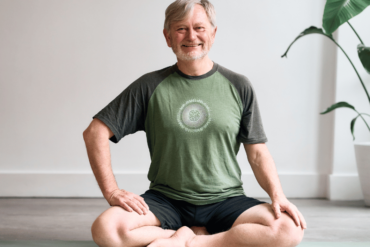A doctor once told me that I had below average lung capacity – but that my lung elasticity was off the scale; I simply have small lungs, but they work very efficiently. While yoga practice is unlikely to give us bigger lungs per se, we can use both posture and breath to help increase the ability of our lungs to expand and stretch. This can help the efficient flow of our breath – our inner air – as well as creating more space in our body for the energy of prāṇa to move freely. And, as working with our inner air in this way helps us become more spacious in our body, we may also find that we allow more space in our mind, moving more efficiently and deeply into meditation. Here are 5 postures which may help both increase our inner air flow and encourage us to become more spacious.
Lateral Lunge
I love lateral movements – extending the side body – and think that they are often under-emphasised in yoga practice. They are an effective way to encourage fuller breath and to help create space in the torso. They can be done in many different positions – seated, standing, kneeling, lying – but I like to bring lateral extensions into simple lunges. Moving laterally towards the front leg side has the added benefit of bringing more space into the front thigh of the back leg, and the psoas area on that side.
The most important elements of this posture are to ensure that the front foot remains well grounded, with the knee pointing straight forward, and to consider cushioning under the back knee to avoid discomfort there. Try to keep a sense of the whole torso extending laterally out of the pelvis, rather than sinking into the shorter side of the body. If the shoulder on the back leg side starts to roll forward, it can be drawn back slightly, but care should be taken to avoid twisting in the lower back. As much as possible, keep some space between shoulders and ears. Gaze can turn toward the upper arm to encourage space in the neck, but this is not essential.
Vīrabhadrāsana 1 with arm variation
In my classes – and my own practice – I often use arm variations in postures to enhance a particular effect. In the ‘classical’ form of warrior 1, bringing the hands together overhead, or even to shoulder width, can sometimes lead to a narrowing of the upper part of the front ribcage, and restrict the ability to use the full lung capacity and/or lung elasticity. Widening the arms into a V shape can help maintain space in the upper chest area and encourage a fuller breath.
Here again it is important that the front foot be fully grounded, with the knee pointing straight forward, and preferably not overtaking the ankle. The precise angle of the front knee is less important than maintaining a stable base, both in the front foot and in the completely grounded back foot, which is turned inwards to allow both hip bones to point forwards. It is also important to maintain energy in the arms, to encourage extension out of the lower back. While the head can be carefully lowered back to help create space in the throat area, the gaze should remain down the nose, in order to maintain some space in the back of the neck and avoid the weight of the head compressing the neck vertebrae.
Uṣṭrāsana
Backbends, or spinal extensions, can, if done mindfully, be very helpful in encouraging the full use of the breath and the creation of space. In camel posture, a good grounding is again important, which is why I prefer not to adopt the common variation with the toes tucked. As with the lunge, padding under the knees, shins, and feet can be useful. Ideally, the hips should be more or less aligned above the knees to help keep space in the lower back – if it is not comfortable to maintain that position while also reaching the feet with the hands, then hands can remain at the top of the buttocks, gently spreading the buttock flesh, or could perhaps be placed on yoga bricks positioned alongside the ankles.
In this posture, as well as maintaining a sense of lengthening out of the lower back, I also encourage students to keep space between the shoulderblades. Here, the opening of the front body will largely take care of itself, so I like to focus on maintaining some space in the back. As in warrior 1, the head can be carefully lowered back, but the gaze should remain down the nose – just like a camel – to avoid neck compression.
Vīrabhadrāsana 2
Warrior 2 is a classic posture which, for me, epitomises the idea of space. Breath can be full and expansive, and we can feel our body opening into the space around it in just about every direction.
A good grounding of the feet is again important, to allow a gentle lift from pelvic floor to crown of head, and the front knee should again be pointing in the same direction as the front foot, preferably not overtaking the ankle. If that is not happening, then the back hip can be turned forward, and the back foot turned inwards, a little more. As with warrior 1, the precise angle of the front knee is less important than a steady base – only then will the body be able to expand easily into the space around it. Both arms should be enthusiastic, but not straining – it is easy here either to allow the back arm to drop, or to be too enthusiastic with the arms and end up tightening around the shoulders and neck. The upper body should be more or less vertical, resisting the temptation to follow the forward arm. Care should be taken not to push out the chest and abdomen and close down the space in the back. Head should be in a neutral position on the neck, gazing into space somewhere beyond the front hand.
Kneeling Garuḍāsana
When we think about establishing a fuller breath, and creating space in the body, it can be easy to neglect the back body. Focussing on expanding the chest can sometimes lead to a closing of the back, but we are three dimensional creatures. For that reason, when I work with the air and space elements, I always like to include postures that create space in the back body. One option is to use the arm position from eagle posture to help create upper back space. While this can be done in the ‘classical’ standing position, with the legs wrapped, I often prefer to focus just on the arms. This can be done seated or, as here, kneeling (again, with cushioning under the knees, shins, and feet and/or between sitting bones and heels, if helpful). For stronger students, the same arm position can also be used in lunges, or in some standing postures.
Once wrapped as much as possible, the arms can remain directly in front of the centre of the chest or, as here, be moved slightly toward the side of the lower arm to increase the sense of space in the back of the shoulder of the upper arm. In this case, care should be taken to keep both sitting bones evenly grounded and not to lean the whole body to the side.
The post 5 Yoga Poses for Air and Space appeared first on Blog – Yogamatters.



